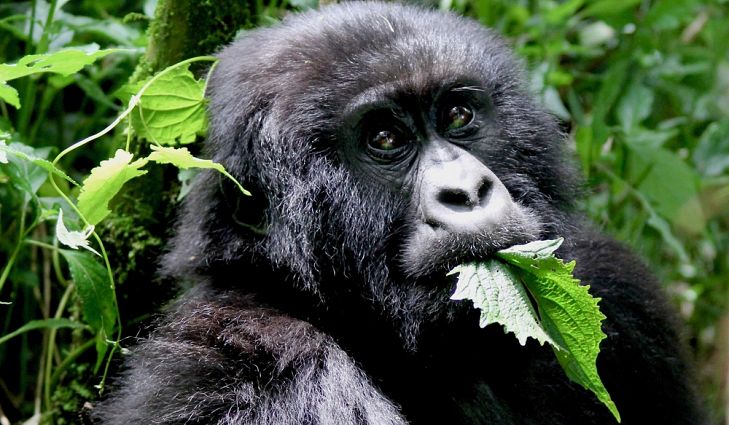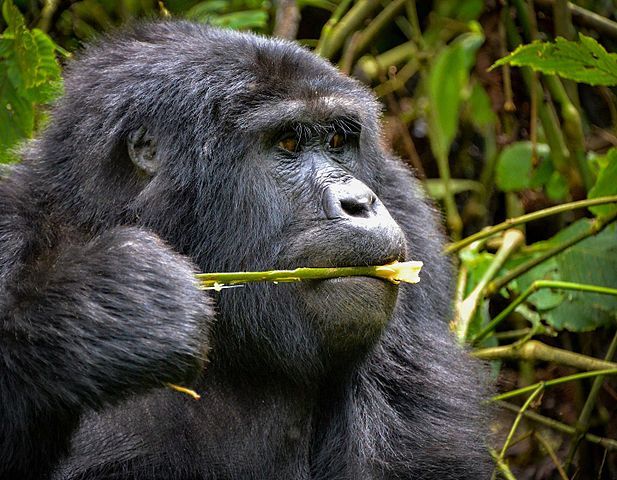What do Gorillas Eat ?
What do Gorillas Eat? Enthusiastic people want to always know what gorillas eat since they share 99% DNA with Human beings but leave in the forests.

Mountain gorillas are endangered primate species which are found in four protected areas namely Bwindi forest national park and Mgahinga national park in Uganda, Volcanoes national park in Rwanda and Virunga national park in the Democratic Republic of Congo.
The endangered gorillas are the largest and strongest primates on earth that share 98% DNA with humans. gorillas are divided in two species of the eastern lowland and western lowland gorillas and subdivided into four subspecies including the mountain gorillas, eastern lowland gorillas, western lowland gorillas and the cross river gorillas which are slightly different from the mountain gorillas due to their habitats and their body shape because the gorillas are named based on the location of their natural habitats.
The mountain gorillas are the great Ape species that live and move around in groups that range from 2 to 40 individual members with the silverback as the leader of the family and holds the leadership position for years whereby it decides on the feeding area, time of feeding, settles disputes, fights and protects the family from other Gorilla groups among others until it becomes old and another silverback takes over. The endangered mountain gorillas live in the tropical rainforests of Africa in national parks namely Virunga national park in the Democratic Republic of Congo with 8 habituated gorilla families available for Congo gorilla trekking on a daily basis, Bwindi impenetrable national park consisting of 18 habituated gorilla families, Mgahinga national park with one habituated gorilla family all located in Uganda and Volcanoes national park in Rwanda with 14 habituated gorilla families. What the gorillas eat depends on their natural habitat and the season or time of the year
Mountain gorillas are herbivores that mainly feed on vegetation as their main diet and green plants including stems, flowers, buds, barks, seeds, bamboo shoots, fruits, grasses, vines, herbs, roots, leaves and young branches. The gorillas also consume ash and soil to regulate their digestive system, neutralize poisonous substances that exist in some of the plants they feed on and add minerals to their system which are not found in the plants that they feed on. They also feed on insects like ants, snails, caterpillars, and termites among others to a small percentage of about 2% so as to get proteins.
Mountain gorillas are different from the lowland gorillas due to the size and the eating habits in that the mountain gorillas are slightly smaller from the lowland gorillas and mainly feed on vegetation or green plants because they live in the rain forests at a high altitude or elevation which doesn’t support a lot of fruit growth compared to the lowland gorillas which are somehow bigger in size and their diet is mostly composed of fruits, and during the dry seasons when the fruits tend to fall down at a high speed they adapt to climbing up in the trees to harvest the fruits and are sometimes forced to eat plenty of seeds and tree barks.
Mountain gorillas in the rainforests of Africa consume over 142 plant species where they feed on leaves, stems, bamboo shoots which make up about 86% of their diet with 7% of the diet composed of the edible roots that they feed on, 3% composed of the flowers, 2% composed of fruits and 2% composed of the ants, grubs, snails.
Gorillas have a set of 32 teeth just like the humans which are used for chewing and process the plants eaten except the adult gorillas which develop long pointed canines when they are mature which are used for fighting other male gorillas. An adult male gorilla consumes about 30 kilograms of vegetation daily while a female gorilla consumes 18 kilograms of vegetation daily. Mountain gorillas rarely drink water because the vegetation they consume is highly tender, tasty, juicy which stores and provides half of the water that the gorillas need to survive and also get water from the mist in the morning.
Mountain gorillas are selective while feeding on the plants in that they don’t complete all the vegetation in one area rather they can consume the roots of a particular plant, eat the stems of another plant, eat the leaves of another and so on hence allowing re-growth of the vegetation that they were feeding on because they keep rotating from one place to another, gorillas can move from in a range of 3 to 6 kilometers each day looking for food to eat and can as well move on two legs and two arms but can also move on two legs and move up to 20 feet distance.
Gorillas live for 35 years and above, the Female gorillas start giving birth between 10 to 12 years of age and have a gestation period of 8.5 months and give birth to one baby after every 2 to 3 years hence giving birth to 4 to 6 offspring’s throughout their lifetime which makes the population growth hard and therefore making it hard for the gorilla population to grow. After birth, the young ones can weigh about 3 to 4 kilograms and feed on breast milk for five months where the mothers feed them once per hour till the age of 4 years. Adult male gorillas weigh from 136kilograms to 196 kilograms and are 5 to 9 feet tall while the females weigh from between 68kilograms to 113kilograms and are 5 feet tall.

Best time to visit Gorillas
Mountain gorillas in Bwindi impenetrable national park, Mgahinga national park, Volcanoes National Park, and Virunga National Park can be visited anytime throughout the year however the best time is during the dry season in the months of June, July, August, September, December, January and February when there is less rainfall, drier grounds for trekking and easy sighting of the gorillas due to short vegetation in the forests compared to the wet season in the months of March to May and October to November when there is rainfalls, difficult to trek and view the gorillas, slippery and muddy grounds among others.
Gorillas communicate with each other using over 25 different sounds like roars, shouts, grunts, screams, growls, hooting, the obvious chest-thumping among others. Gorillas communicate when they want to find food, express distress, offering support to each other, when mating and so on.
Gorillas are herbivores that depend 100 percent on their habitats, which provides them with food in the form of plants, fruits, vegetation and also shelter. These are however basic items for their survival.


